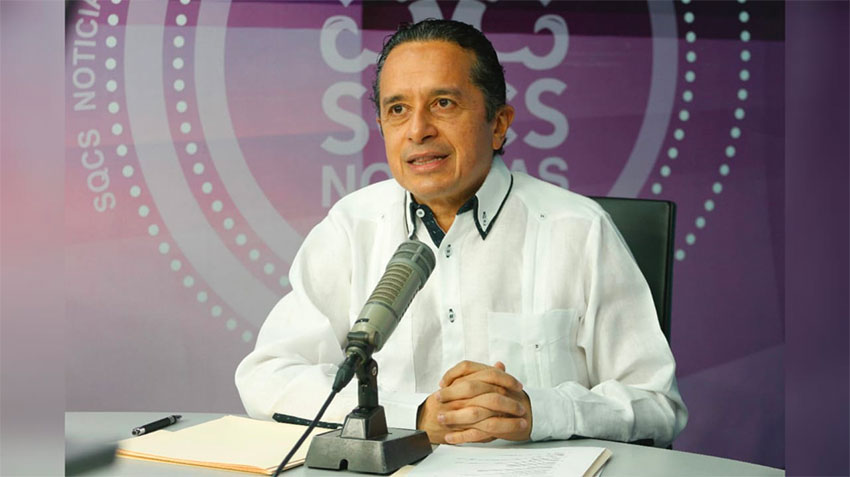The governors of several states have indicated that they won’t impose stricter coronavirus restrictions this week despite being allocated a “red light” on the federal government’s latest “stoplight” map, used to indicate the risk of infection.
The governors of Baja California Sur (BCS), Yucatán, Quintana Roo and Querétaro all said they will maintain the less severe “orange light” restrictions that have been in place in their states in recent weeks.
Those four states were among nine that switched from red to orange on the map presented by the federal Health Ministry on Friday.
BCS Governor Carlos Mendoza Davis said the state’s health safety committee had voted in favor of maintaining the risk level at orange. He asserted that the committee is a responsible decision-making body with the best interests of BCS residents at heart.
Mendoza acknowledged that coronavirus case numbers have recently risen but attributed the spike to an increase in testing. He said that a declining Covid-19 fatality rate in BCS and the availability of hospital beds were among the factors considered by the health committee before deciding to maintain the “orange light” risk level.
BCS has recorded 3,107 confirmed cases since the beginning of the pandemic – the fifth lowest total among Mexico’s 32 states – of which 895 cases are currently estimated to be active. The state has the lowest Covid-19 death toll in the country, with 117 fatalities, according to federal data.
Data presented at the federal Health Ministry’s coronavirus press briefing on Sunday night showed that 27% of general care hospital beds set aside for coronavirus patients in BCS are currently occupied while 34% of those with ventilators are in use.
In Yucatán, where there are an estimated 1,413 active coronavirus cases, the state Health Ministry decided that it too would maintain the risk level at orange this week.
Before the state was allocated a “red light,” Governor Mauricio Vila announced the reimplementation of a ley seca, or dry law, prohibiting the purchase of alcohol all week. He also said that residents were banned from using their cars at night, with the driving restriction beginning at 9:00 p.m. in coastal communities and at 10:30 p.m. elsewhere, and concluding at 5:00 a.m.
Yucatán has recorded 7,226 confirmed coronavirus cases since the beginning of the pandemic and 699 deaths.
Quintana Roo Governor Carlos Joaquín reiterated Saturday that his government has its own “stoplight” system and therefore won’t respect that of federal authorities.

“Orange light” restrictions will remain in place this week in the northern half of the state, which includes the popular tourism destinations of Cancún, Playa del Carmen and Tulum, but “red light” rules will persist in the southern half, Joaquín said.
Quintana Roo authorities announced the harsher restrictions for the south a week before the federal government announced that the entire state was to transition to red on its “stoplight” map as of today.
The Caribbean coast state has recorded 6,161 confirmed cases, of which 1,273 are estimated to be active, and 792 Covid-19 deaths.
Querétaro Governor Francisco Domínguez Servién said that his government won’t shut down any economic activity that has already been permitted to restart.
“We will continue with the economic activities that have already been reactivated but with greater vigilance of compliance with health measures,” he said.
Querétaro has recorded 2,896 confirmed cases – the fourth lowest total in the country – of which 399 are estimated to be active. The Bajío region state has also recorded 403 Covid-19 deaths.
Although stricter restrictions won’t be imposed in Querétaro this week, Domínguez said he was prepared to place further limits on activities if the coronavirus situation worsens.
Jalisco Governor Enrique Alfaro preceded his counterparts in BCS, Yucatán, Quintana Roo and Querétaro in speaking out against the federal government’s updated “stoplight” map, asserting on Friday that Deputy Health Minister Hugo López-Gatell had allocated a “red light” to his state because “he felt like it.”
He charged that the decision was politically motivated and charged that López-Gatell’s “impulses have cost Mexico a lot of lives.”
For his part, Tabasco Governor Adán Augusto López claimed Friday that the deputy minister has presented incorrect coronavirus data for the Gulf coast state.
“I can’t [put up] with Gatell. I don’t know where he gets some of his numbers from,” he said during a hospital visit.
Despite the governors’ airing of their public grievances with the federal government, López-Gatell said Sunday that there is no dispute with nor animosity toward the state leaders.
He said the federal government respects and supports the decisions that states take with regard to the tightening or easing of coronavirus restrictions.
“We’re not going to oppose them,” López-Gatell said.
However, the federal government will not cease to provide recommendations to help the state’s combat their local coronavirus epidemics, he added.
The deputy minister emphasized that the development of the “stoplight” map is not only his responsibility but rather that of all federal health officials.
“It’s not López-Gatell’s stoplight, it’s the institutional stoplight of federal health authorities,” he said.
The official brushed aside the remarks of the Tabasco governor, saying that they were motivated by a “slight lag” in the reporting of data that has now been explained to him.
The coronavirus pandemic has become a highly politicized issue in Mexico with many government critics accusing President López Obrador and his government of first downplaying then mismanaging the health crisis, and not doing enough to support the economy amid the coronavirus-induced downturn.
Some governors, especially those who represent the conservative National Action Party, have added their voices to the criticism.
Meanwhile, coronavirus case numbers and fatalities continue to mount, with Mexico’s case tally now above 340,000 and the official death toll approaching 40,000.
Source: El Universal (sp), El Financiero (sp), La Jornada (sp)
